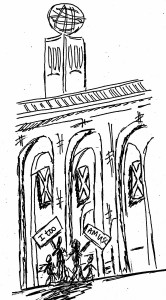In light of its unsavory history, rename Von KleinSmid Center
Professor George Sanchez, the Vice Dean of Diversity and Strategic Initiatives for Dornsife College of Letters, Arts and Sciences, compiled a selective timeline documenting the history of racism at USC at the diversity forum last Wednesday. Perhaps the most jarring of his findings was about the man the Von KleinSmid Center is named after: chancellor for life, possible white supremacist sympathizer and former USC president Rufus B. Von KleinSmid. As USC continues to memorialize Von KleinSmid by granting him the namesake of a humanities building and library, USC literally houses structural racism and further institutionalizes the production of a campus climate that is inherently intolerant. The lack of transparency on Von KleinSmid aside, it is important to consider what this means to students of color on campus — their rights to safety, inclusion and basic dignities are in the shadow of a man whose legacy was built on keeping people like them outside of the Walls of Troy. Above all else, USC needs to remove Von KleinSmid’s name from all buildings as well as rid the plaza of his bust and its accompanying eulogy.
The University must shed light on its own history and acknowledge that much of its foundation was built on the backs of discrimination, racism and xenophobia. According to Dr. Sanchez’s timeline, in 1928 Von KleinSmid became the founding member of a leading eugenics organization called the Human Betterment Foundation. In 1945, he refused to send transcripts to colleges enrolling Japanese-American citizens who were released from internment camps. Not only did he work to prevent these students from getting an education, but he also sent them to the camps in 1942, according to the same source. During his presidency in 1946, the Jewish Journal reports, a cross burning took place on the lawn of a Jewish fraternity house. Also according to the same source, admissions at this time had an informal quota system, which allegedly allowed one Jew to attend the University per year.
Condemning the act of revisionism renders the purpose behind academia futile — if an institution of higher education intends to hold onto a legacy as antiquated and sullied as Von KleinSmid’s, then what can be said about that very same institution’s dedication to innovation, critical theory and research? Much of the criticism of renaming buildings defends racist figureheads and argues that purging a school of its history is useless. What needs to be understood is that this is not an issue of a few students disliking USC’s history or simply a representation of what the norm was at that time; calls to rename buildings are, however, an active movement to remove racism from a pedestal and a process in which history is accurately represented — not slanted — by the narratives of exceptionalism commonplace in American universities.
On the topic of Von KleinSmid, to which the University “affectionately” refers to as “Dr. Von” on its website, USC has said that “his presidency left a remarkable legacy: a University transformed from a modest local denominational institution with a scattering of schools and facilities to a consolidated secular institution with 24 schools and colleges, 16 buildings and national accreditation and standing.” It is clear that the nature of the University’s veneration of Von KleinSmid has more to do with the material gains accounted for under his presidency than his role as the leader of intellectuals.
Student-led campaigns such as “I, Too, Am USC” note the prevalence of discrimination and the potency of racism on campus robbing students of color of their ability to identify as Trojans. The need for such a campaign calls into question: What is a greater priority to the administration — our identity as a progressive and inclusive campus in today’s terms or our history of bigoted male leaders? The answer to this question depends on who is truly the face of USC. To further contextualize this, Von KleinSmid is a dark symbol of the University in the same way that the confederate flag is a dark symbol of America; however, today it is next to obscene to wave a Confederate flag in much of America because of what it represents and what is refers to historically — slavery. The same can be said for VKC.
It is impossible to revere a man for discrimination, racism and xenophobia while also respecting the space of international students, students from immigrant families and students of color. In doing so, USC ensures that the oppression and degradation of students of color is certainly included — but the school’s respect for students who face racism is not.
Lida Dianti is a junior majoring in international relations. Her column, “That’s So Racist!,” runs Wednesdays.


“What needs to be understood is that this is not an issue of a few students disliking USC’s history or simply a representation of what the norm was at that time; calls to rename buildings are, however, an active movement to remove racism from a pedestal and a process in which history is accurately represented — not slanted — by the narratives of exceptionalism commonplace in American universities.”
what is this sentence where is your editor